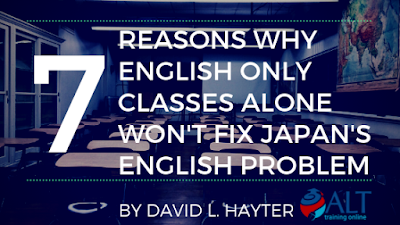Bio: David L. Hayter works as a Lead Assistant Language Teacher (ALT) in Japan. Although he primarily teaches junior high school, he has taught all the grades from kindergarten through ninth grade.
Aside from teaching classes in junior high school, his other duties include training and managing new ALTs, designing and delivering teacher training workshops, and performing other duties for his local Board of Education (BOE).
When he’s not teaching, he actively volunteers in his community, enjoys playing video games, loves to cook, trains hard, practices martial arts, podcasts, helps run the ALT Training Online blog and writes for his blog, Yokkaichi Connections.
Over the years, the Japanese government has placed a large emphasis on the need for “English only” classes and immersion in English education. Having studied Spanish and Japanese in the US before coming to Japan, I can say that these techniques are very effective for preparing students to communicate in real-world situations.
However, it seems that this type of education won’t be beneficial for the Japanese students who are learning English if the content they are studying and how they are being taught doesn’t change.
Let’s take a closer look at the current situation and examine the barriers to teaching “all English” classes.
Students are all grouped together regardless of level
As you may already know, students in Japan are all placed in the same class regardless of actual English ability. This is a stark contrast to language education in other countries where students must pass one level to move on to the next level; the idea being that they have to master the basics before they can move on to the more difficult material.
This means that you may have some students who know everything you’re about to teach them sitting next to other students who still haven’t mastered the basic sentence structures they learned earlier in the year.
Lack of qualified teachers (especially in ES)
Most teachers in Japan teach English the way they were taught. In my experience, the best teachers are those who have studied abroad or lived in an English speaking country for an extended amount of time.
These teachers have first-hand experience with using English as a means of communication to express their own ideas and to get new information. Some of these teachers are able to transfer this to their classes and it helps give their lessons context and meaning.
Other teachers who may not have this experience tend to rely on the textbook and word-for-word translations when teaching. Their lessons lack context and don’t reflect real-world situations. It’s probably hard for them to break these old habits, especially since they are usually focused on getting their students ready to pass tests.
The materials have A LOT of Japanese
When I open my English textbook, the first thing I see is … wait for it … Japanese! A lot of the texts and study materials have instructions in Japanese and this immediately breaks the immersive environment we’re trying to create. This may get better over time, but it’s a tough hurdle to get over at the moment.
Japan loves tests
Many students have the ultimate goal of learning English so they can do well on entrance exams. I can’t say that I blame them either.
If you think about it, what reward does a student get for speaking English well? What reward does a JTE get for using all English in the classroom? Is there any consequence for not doing so? Without any carrots or sticks beside intrinsic motivation, it’ll be hard to bring about change.
Until the tests are given entirely in English, it will be hard to change the classes
Lack of an “English environment”
As you may already know, students in Japan spend most of the day in their classroom as the teachers move around to different classes. While some schools do have dedicated classrooms for teaching English, this is not always the case.
When teaching English in a typical classroom, the students are surrounded by Japanese. This also breaks the immersive environment we’re trying to create.
Having classrooms for English allows the teachers to fill the room with English materials and helps students stay in the “English mode” for longer.
It’s a good start but not a comprehensive strategy
If Japan was really serious about improving its English education, a lot more work will be needed aside from having their classes taught entirely in English. It’s definitely something that the government should pursue, but there is still a long way to go in making the types of changes necessary to improve Japan’s English ability.
Don’t have any ideas? We have a list of topics to write about that need a writer. Email in your interest to write and we can set you up.
For upcoming blogs see the blogs tab here: http://www.alttrainingonline.com/blog.html


